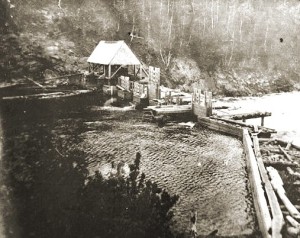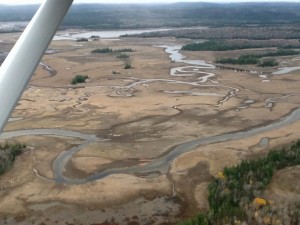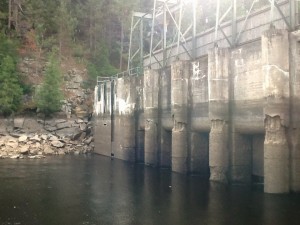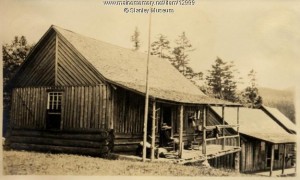Dams have a major impact on sporting camps and recreational opportunities. What should be done with old dams? Should they be removed or maintained? How and by whom? Big questions!
Maine’s classic sporting camps are typically located on the shore of a lake whose water level is maintained by a dam. Virtually all of the dams were built a century ago to hold water for driving logs to the mills in early spring.
Now, over one hundred years later, logs are no longer transported via streams. These old dams remain unmaintained and present a troubling predicament for sporting camps, landowners and those living in downstream flood zones.
The Maine Sporting Camp Heritage Foundation’s challenge is to create a standardized policy for dealing with dams, so that they may be improved, or removed, without undue hardship on all the affected parties – sporting camp owners, forest landowners, Maine’s fish and wildlife biologists and the recreating public.
Here are two excellent examples of how difficult, and expensive, a problem that Maine’s classic sporting camps now face – the dams at Second Roach Pond and Grand Lake Matagamon.
1. Dam at Second Roach Pond
If any dam restoration were to have a successful outcome, this would be it. Unfortunately, despite great intentions, excellent funding and professional staffing, rebuilding the dam turned into a disaster – very costly to the environment and the dam’s owner.
The dam at Second Roach Pond was a very old a rock ramp dam. It does not produce hydroelectricity, has no gates or fish ladder. It had been failing for years, and concern was that it would fail completely in the near future.
Second Roach Pond is home to Medawisla Wilderness Lodge, a classic Maine sporting camp. Failure of the dam would be devastating to the viability of Medawisla Wilderness Lodge. There are many other sporting camps on small lakes having similar dams, in similar states of disrepair.
Fortunately, Medawisla Wilderness Lodge, the dam and the land around Second Roach Pond are all owned by the Appalachian Mountain Club (AMC) – a well meaning, and well funded, organization that hoped to renovate and operate the lodge.
Walter Graff of the AMC said, “We were afraid that the dam would fail, so we went to the Land Use Planning Commission to see if we could fix the dam or reconstruct the dam, and in the end we decided to reconstruct it. That was to protect the pond for recreational value — people canoeing and swimming — but also to protect the wetlands the dam provided.”
The AMC’s superb fundraising ability was critical, and provided for an engineering study, redesign and rebuilding of the dam. Plans were drawn, state permits were obtained and contractors engaged. No privately owned sporting camps could have taken on this major task.
Sadly, the project did not turn out well. Nearly one mile of the Roach River (described as prime nursery habitat for landlocked salmon and brook trout) ended up dewatered for 10 days while construction was under way – an environmental SNAFU (“Situation Normal, All Fowled Up”). Aquatic life was decimated. Great intentions were made, but the outcome was bad.
After the State’s investigation and negotiations about fines and restitution, an agreement between the State and the Appalachian Mountain Club required them to hire an engineering firm not involved with the previous dam to plan and design a new dam.
According to the Maine Land Use Planning Commission, the Appalachian Mountain Club has paid a $15,000 civil penalty, and according to the settlement agreement, will “complete or substantially contribute” to a project that improves fish passage at a stream or river road crossing at a cost of $70,000 or more.
All that would have put any other Maine sporting camp out of business forever!
2. Dam at Grand Lake Matagamon
Many of Maine’s 100 year old sporting camps are situated on lakes having much more complex dams than that at Second Roach Pond. The Matagamon dam situation illustrates how expensive a repair project might be.
The Matagamon dam was originally built to control large flows of water, first for log driving, later for power generation and flood control, and currently for recreation (fishing, canoe trips).
The dam forms the outlet of Grand Lake Matagamon, which spans the northern area of Baxter State Park (T6 R8 WELS). Grand Lake Matagamon is a headwater to the East Branch of the Penobscot River. The lake itself contains acres 4868 within its 61.3 mile perimeter and has a total drainage area of 496 square miles. The maximum depth is 95feet. Additional flows coming to it all the way from Allagash, Churchill and Telos Lakes. The lake has excellent Brook Trout and Salmon fishing.
Operation of Matagamon Dam is essential to the cold-water ecosystem; supporting a high quality sport fishery in the East Branch system. Regulating the flows in the East Branch has been critical to the rehabilitation of the wild brook trout, landlocked and Atlantic salmon. Stable, regulated water levels in the lake are necessary for a self sustaining lake trout population, and maintaining waterfowl nursery.
The existing concrete dam was built in 1941 to replace a log and timber crib dam originally built in the 1800’s. The dam has flow control gates and a fish ladder. Ownership of Matagamon Dam was transferred to Matagamon Lake Association in 2001 for the purpose of maintaining the structure for the benefit of fisheries, wildlife, recreational values and downstream safety (flood control).
However, the dam is almost 75 years old, and operating it incurs considerable expenses. For instance, in 2003 the fish ladder was repaired. The old wood was removed around the gates and hauled away. New hemlock planking replaced what was taken out. The gates were replaced with new precut aluminum gates.
And, the now the dam’s entire concrete structure needs major repairs. As you can see in the photo, time and weather (especially winter ice) take quite a toll on the dam. The amount quoted in 2010 for dam updates was in $270,000.00 range.
While abandoning the dam is an option, there would be adverse impact on camp owners, freshwater fisheries, Atlantic Salmon restoration program, wildlife and waterfowl nesting and flood control. Recreation on the river and downriver power generation would certainly be changed as summer flows would not be maintained.
For further info about the Matagamon Dam, visit the Matagamon Lake Association’s website or contact the Association. E-mail: ddudley@hughes.net; or write to: Matagamon Lake Association, Inc. P.O. Box 676, Patten, Maine 04765





